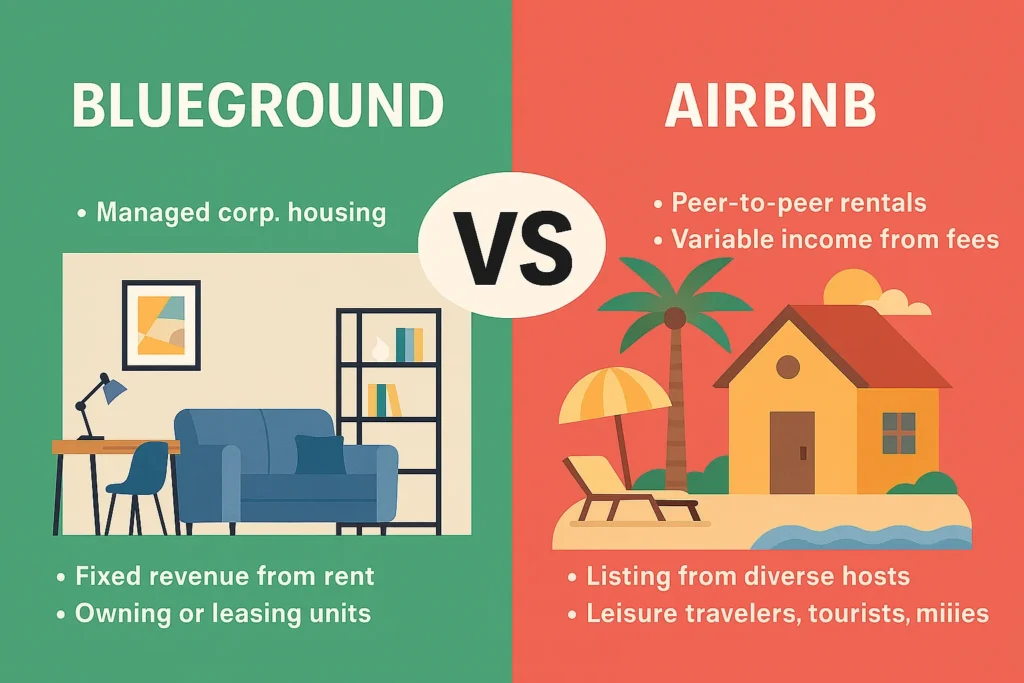In 2025, the global short-term rental and flexible housing market is more dynamic than ever. With remote work, digital nomadism, and “bleisure” (business + leisure) travel shaping consumer habits, platforms like Blueground and Airbnb have positioned themselves as leaders in the accommodation-as-a-service economy.
But while both operate in the property rental space, their business models are fundamentally different. For startup founders and proptech entrepreneurs aiming to enter this sector, understanding these differences is crucial.
Should you emulate Airbnb’s marketplace model, or replicate Blueground’s asset-light property management approach? This blog will help you break down their business architectures, revenue strategies, cost drivers, and growth playbooks to determine which model fits your vision.

What is Blueground?
Blueground is a tech-enabled furnished apartment rental platform that offers fully-managed, turnkey living spaces for stays of 30 days or more. Founded in 2013 and headquartered in New York, Blueground leases high-end properties from landlords, furnishes them, and then sublets them to renters on medium- and long-term stays.
Key Highlights:
- Offers move-in-ready apartments in 30+ cities globally
- Caters to expats, business travelers, digital nomads
- Operates on a lease-to-sublet model
- Focuses on inventory control and brand consistency
What is Airbnb?
Airbnb is a global peer-to-peer rental marketplace that connects hosts (property owners) with guests seeking short-term stays. Founded in 2008, Airbnb disrupted the traditional hotel industry by allowing anyone to monetize their space—whether it’s a spare room, apartment, or villa.
Key Highlights:
- Active in 220+ countries and regions
- Offers short-term and long-term stays
- Hosts list and manage their own properties
- Operates purely as a platform (no real estate owned)
Business Model of Blueground
Blueground runs an asset-light operational leasing model. It signs long-term leases with property owners, transforms units into premium rentals, and monetizes them through monthly bookings.
Revenue Streams:
- Rental Income: Markup on subleased units
- Add-ons: Cleaning, utility, concierge services
- Corporate Housing Deals: B2B rentals for companies
- Dynamic Pricing: Revenue-optimized pricing strategies
Cost Structure:
- Lease commitments to landlords
- Furnishing, maintenance & insurance
- Tech infrastructure (app, booking engine, pricing AI)
- Local operations (cleaning, check-ins, guest support)
- Marketing & acquisition costs
Key Partners:
- Real estate developers & property managers
- Furniture & logistics providers
- Utility and cleaning service vendors
- Corporate relocation agencies
- Local city authorities for compliance
Growth Strategy:
- Expand into tier-1 and tier-2 global cities
- Improve occupancy rates through B2B clients
- Standardize experience to build a premium rental brand
- Enhance tech-driven guest experience
Learn More: Business Model of Blueground Explained : Revenue & Strategy
Business Model of Airbnb
Airbnb is a two-sided marketplace model that earns a commission on bookings made between hosts and guests. It does not own or lease properties but facilitates transactions and provides tools for both parties.
Revenue Streams:
- Service Fees: 14–16% from guests; 3–5% from hosts
- Experiences Platform: Commission on host-led tours
- Airbnb for Work: Corporate travel bookings
- Airbnb Luxe & Airbnb Plus: Premium curated listings
- Host Tools: Photography, marketing, insurance
Cost Structure:
- Platform development (web, app, AI, security)
- Payment processing and customer support
- Regulatory and legal compliance
- Marketing and loyalty programs
- Insurance and liability coverage (AirCover)
Key Partners:
- Hosts and property managers
- Payment processors (Stripe, PayPal, etc.)
- Insurance providers
- Local governments and tourism boards
- Experience hosts and affiliates
Growth Strategy:
- Focus on longer stays (1 month+)
- Promote Airbnb Rooms and local immersion
- Invest in AI-driven trip personalization
- Increase supply in non-urban and secondary markets
Learn More: Airbnb Business Model: How Airbnb Makes Money & Grows Globally
Comparison Table: Blueground vs Airbnb
| Feature | Blueground | Airbnb |
|---|---|---|
| Model Type | Lease-to-sublet rental platform | Peer-to-peer rental marketplace |
| Property Control | Yes (leases properties) | No (relies on hosts) |
| Stay Duration | Mid-to-long term (30+ days) | Short-term to long-term |
| Revenue Stream | Rental income + services | Booking fees + experiences |
| Brand Experience | Standardized, hotel-like | Varies by host |
| Customer Base | Expats, business travelers, nomads | Leisure travelers, families, remote workers |
| Tech Focus | Operational tech & inventory management | Marketplace algorithms & personalization |
| Cost Base | High (leases, furnishing, operations) | Low (platform-driven) |
| Risk Exposure | Market demand & lease obligations | Regulatory, reputation, host quality |
Pros & Cons of Blueground Model
Pros:
- Control over inventory = consistent guest experience
- Higher margins from longer stays
- Easier to attract corporate clients
- Strong brand recall in premium housing
Cons:
- Capital-intensive (furnishing, leasing)
- High operational overhead
- Risk tied to vacancy & lease terms
- Scaling limited to licensed cities
Pros & Cons of Airbnb Model
Pros:
- Scalable and global with low operating cost
- Diverse listings for all types of travelers
- Fast go-to-market potential
- Revenue through network effect
Cons:
- Quality inconsistency across hosts
- Heavily impacted by local regulations
- Vulnerable to bad actors (hosts or guests)
- Reputation depends on third-party behavior
Market Data: Growth, Revenue & Funding (2025)
| Metric | Blueground | Airbnb |
|---|---|---|
| Year Founded | 2013 | 2008 |
| Active Cities | 30+ | 220+ countries |
| Total Funding | $350M+ | IPO in 2020, valued $90B+ |
| Annual Revenue (2024 est.) | $300M+ | $10.5B+ |
| Monthly Bookings | ~70,000 | Millions |
| Customer Rating Avg. | 4.8/5 | 4.7/5 |
| Growth Focus 2025 | Corporate + long-term stays | Experiences + affordable rooms |
Which Model is Better for Startups in 2025?
- If you aim for standardization, high-end clientele, and long-term stays, Blueground’s model is attractive—but it demands higher capital and strong real estate operations.
- If you prefer a scalable, low-asset model that thrives on network effects and user-generated supply, Airbnb’s marketplace is your blueprint.
Hybrid models are emerging—mixing direct control (for quality) with host onboarding (for scale).
Choose Blueground-style if…
- You’re targeting business travelers, expats, or digital nomads
- You want control over the full guest experience
- You’re ready to manage real estate leases and furnishing
Launch your furnished rental app with Miracuves’ Blueground Clone
Choose Airbnb-style if…
- You want a scalable peer-to-peer platform
- You’re entering markets with diverse hosts & tourists
- You aim to monetize through commissions and experiences
Build your vacation rental marketplace with Miracuves’ Airbnb Clone
Conclusion
Whether you’re drawn to the consistency and quality of Blueground or the scale and diversity of Airbnb, Miracuves provides robust, white-label solutions for both business models.
From app development to backend logistics, booking engines to revenue optimization, we help you go live faster with enterprise-grade technology.
FAQs
Can I combine both models in one app?
Yes, some startups offer both platform listings and managed rentals. You can blend them based on city, segment, or inventory type.
Which model has higher profit margins?
Blueground has higher per-unit margins but higher costs. Airbnb earns lower margins but benefits from volume and scale.
What are the risks of leasing properties like Blueground?
If demand drops, you may face liability for empty units and fixed costs. However, with Miracuves’ Blueground clone starting at $2899, you can use built-in dynamic pricing and B2B modules to minimize risks.
Is Airbnb’s model legal everywhere?
No. Many cities regulate or restrict short-term rentals. Startups must navigate local housing laws and zoning rules.
Which model is faster to launch?
Airbnb-style platforms are easier to launch with low capital investment. Blueground requires infrastructure and partnerships.








